pt-BR
nomes no trilho de navegação

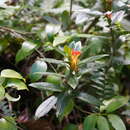
Columnea is a genus of around 200 species of epiphytic herbs and shrubs in the family Gesneriaceae, native to the tropics of the Americas and the Caribbean. The tubular or oddly shaped flowers are usually large and brightly colored – usually red, yellow, or orange – sometimes resembling a fish in shape. A common name is flying goldfish plants (see also the related Nematanthus) due to the unusual flower shape.
The genus was named by Carl Linnaeus after the Latinized spelling of the name of the 16th-century Italian botanist Fabio Colonna (Latin: Fabius Columnus).[1][2]
The segregate genus Bucinellina is considered by many botanists a synonym of Columnea. A full list of the species now accepted in the genus, along with their synonyms, can be found at the World Checklist of Gesneriaceae.
Columnea species grow as epiphytic plants in the wild and require bright light, good air circulation, and a well-drained growing medium that is allowed to dry out slightly between waterings. They are very tolerant of underpotting and seem to bloom best when potbound. Most are tropical plants and are easy to grow under indoor or greenhouse conditions but some species come from high altitudes and require cooler temperatures to grow well or bloom. Many of the species are seasonal bloomers, but hybrids and cultivars can be more or less continuously blooming.
The hybrid Columnea × banksii has gained the Royal Horticultural Society's Award of Garden Merit.[3]
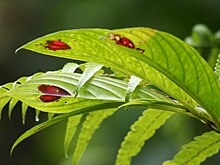
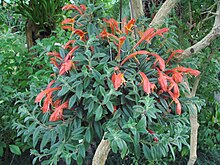
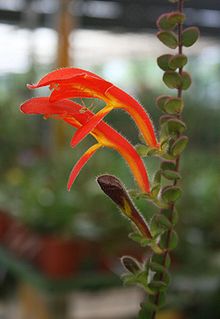
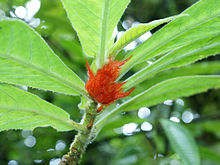

The species classified under Columnea include the following:[4]
Columnea is a genus of around 200 species of epiphytic herbs and shrubs in the family Gesneriaceae, native to the tropics of the Americas and the Caribbean. The tubular or oddly shaped flowers are usually large and brightly colored – usually red, yellow, or orange – sometimes resembling a fish in shape. A common name is flying goldfish plants (see also the related Nematanthus) due to the unusual flower shape.
The genus was named by Carl Linnaeus after the Latinized spelling of the name of the 16th-century Italian botanist Fabio Colonna (Latin: Fabius Columnus).
The segregate genus Bucinellina is considered by many botanists a synonym of Columnea. A full list of the species now accepted in the genus, along with their synonyms, can be found at the World Checklist of Gesneriaceae.
Columnea es un género de cerca de 200 especies de epifitas herbáceas y arbustivas, fanerógamas de la familia Gesneriaceae, nativa de América tropical y Caribe.[2]
El género segregante Bucinellina es considerado por muchos botánicos un sinónimo de Columnea.
Hierbas o subarbustos, terrestres o epífitos, tallos erectos, decumbentes o péndulos. Hojas opuestas, los pares iguales a muy desiguales, u ocasionalmente verticiladas, láminas lineares, lanceoladas, ovadas, elípticas a obovadas, pecioladas o no. Inflorescencias axilares, de 1 o más flores; lobos del cáliz 5, libres o apenas connados; tubo de la corola cilíndrico a ventricoso, con frecuencia fuertemente zigomorfo, limbo erecto, patente o reflexo, frecuentemente más o menos connado; estambres 4, didínamos, exertos o incluidos, anteras con dehiscencia longitudinal; disco de 5 glándulas libres o reducidas a una glándula dorsal solitaria y bilobada; ovario súpero, estilo incluido o exerto, estigma bilobado o estomatomorfo. Fruto una baya globosa a ovoide.
El género fue descrito por Carlos Linneo y publicado en Species Plantarum 2: 638. 1753.[3] La especie tipo es: Columnea scandens L.
El nombre del género fue nombrado en honor de Fabio Colonna (en Latín Fabius Columnus) (1567-1640), profesor de botánica en Nápoles. Él fue el primer ilustrador en placas de cobre.[1]
Columnea es un género de cerca de 200 especies de epifitas herbáceas y arbustivas, fanerógamas de la familia Gesneriaceae, nativa de América tropical y Caribe.
El género segregante Bucinellina es considerado por muchos botánicos un sinónimo de Columnea.
Columnea est un genre de plantes de la famille des Gesneriaceae. Il comprend environ 200 espèces d'arbustes et de plantes épiphytes et est originaire d'Amérique tropicale et des Caraïbes. Les fleurs tubulaires ou de forme irrégulière sont généralement de grande taille et de couleurs vives – habituellement rouge, jaune, ou orange – et ressemblent parfois à un poisson.
Le nom générique a été créé par Carl von Linné, après l'orthographe du nom latinisé du botaniste italien du XVIe siècle Fabio Colonna. [1]
Le genre Bucinellina est considéré par de nombreux botanistes comme synonyme de Columnea. Une liste complète des espèces maintenant acceptées dans le genre, ainsi que leurs synonymes, peut être trouvée à la Liste mondiale des Gesneriaceae.
Les espèces de plantes classées sous le nom de Columnea sont les suivantes[1]:
Columnea est un genre de plantes de la famille des Gesneriaceae. Il comprend environ 200 espèces d'arbustes et de plantes épiphytes et est originaire d'Amérique tropicale et des Caraïbes. Les fleurs tubulaires ou de forme irrégulière sont généralement de grande taille et de couleurs vives – habituellement rouge, jaune, ou orange – et ressemblent parfois à un poisson.
Le nom générique a été créé par Carl von Linné, après l'orthographe du nom latinisé du botaniste italien du XVIe siècle Fabio Colonna. [1]
Le genre Bucinellina est considéré par de nombreux botanistes comme synonyme de Columnea. Une liste complète des espèces maintenant acceptées dans le genre, ainsi que leurs synonymes, peut être trouvée à la Liste mondiale des Gesneriaceae.
Columnea è un genere di piante della famiglia delle Gesneriaceae, che comprende circa 200 specie di piante epifite, diffuse in America del Sud e nei Caraibi.
In natura cresce nelle foreste pluviali, attaccata ai rami degli alberi con le radici che spuntano dai fusti lunghi e ricadenti. Assorbe nutrimento dai tronchi delle piante che le ospitano e dall'umidità dell'aria.
Columnea è un genere di piante della famiglia delle Gesneriaceae, che comprende circa 200 specie di piante epifite, diffuse in America del Sud e nei Caraibi.
Columnea L. é um género botânico pertencente à família Gesneriaceae, nativo da América tropical e Caribe.[1]
Columnea L. é um género botânico pertencente à família Gesneriaceae, nativo da América tropical e Caribe.